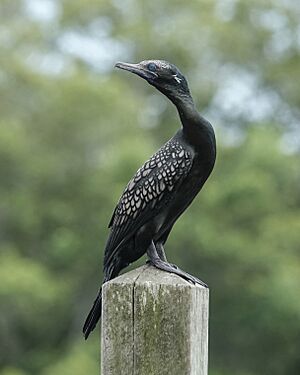Little black cormorant facts for kids
Quick facts for kids Little black cormorant |
|
|---|---|
 |
|
| Conservation status | |
| Scientific classification | |
| Genus: |
Phalacrocorax
|
| Species: |
sulcirostris
|
| Synonyms | |
|
|
The little black cormorant (Phalacrocorax sulcirostris) is a type of cormorant, which are seabirds. You can often find this bird in rivers and lakes across most parts of Australia and northern New Zealand. In New Zealand, it's also called the little black shag. This bird is about 60 centimetres (2 feet) long and is completely black with cool blue-green eyes.
Contents
About the Little Black Cormorant
The little black cormorant was first officially described in 1837 by a German scientist named Johann Friedrich von Brandt. He gave it the scientific name Carbo sulcirostris. Today, it's known as Phalacrocorax sulcirostris. The name Phalacrocorax is a Latin word for cormorant. The second part, sulcirostris, means "furrow-billed," which describes its beak. There are no different types (subspecies) of this bird; it's just one kind.
What the Little Black Cormorant Looks Like
The little black cormorant is a small bird, usually about 60 to 65 centimetres (24 to 26 inches) long. It has shiny black feathers that look a bit green on its back. When it's time to breed, some white feathers might appear around its head and neck, and it might even have a whitish eyebrow. After breeding season, its feathers become a duller brown. Both male and female birds look the same. Their long, thin beak is grey, and their legs and feet are black. Adult birds have green eyes, while younger birds have brown eyes.
Where the Little Black Cormorant Lives
You can find the little black cormorant in many places, from the Malay Peninsula through Indonesia (but not Sumatra) and New Guinea. They also live all over Australia and in New Zealand's North Island. These birds mostly prefer fresh water, like lakes and rivers. Sometimes, they can be seen in calm coastal areas too. You'll almost always find them very close to water.
Little Black Cormorant Behaviour
Little black cormorants are more social than other cormorants. They often gather in large groups or flocks. Sometimes, you might even see these groups flying in a "V" shape, just like geese!
What the Little Black Cormorant Eats
The little black cormorant mainly eats fish. They eat more fish than the little pied cormorant, which often lives in the same places but eats more crabs and shrimp. In a study done in New South Wales, Australia, it was found that more than half of their diet was made up of common carp, which are fish that were brought to Australia.
These cormorants have a cool way of hunting when they are in a group. They fly a short distance, flapping their wings against the water, then land and wait for others to land in front of them. While waiting, they dive underwater to catch fish that are trying to escape. They come back up, swallow their fish, and then move forward again. A group of hundreds of cormorants can stay in a tight formation, moving together as they hunt.
Reproduction and Life Cycle
Little black cormorants usually breed once a year. In southern Australia, this happens in spring or autumn. In tropical areas, they breed before or after the monsoon season. They build a small nest out of dried branches and sticks. These nests are usually found in the forks of trees that are standing in water. They often build their nests near other waterbirds like herons, ibis, or spoonbills.
Female cormorants lay three to five (sometimes six or seven) pale blue, oval-shaped eggs. Each egg is about 48 by 32 millimetres (1.9 by 1.3 inches). The eggs have a thin layer of a mineral called lime, which makes them look matte white. As the breeding season goes on, the eggs and nest can get quite stained.
Images for kids
-
Adult in East Perth
-
Manly (near Sydney)






